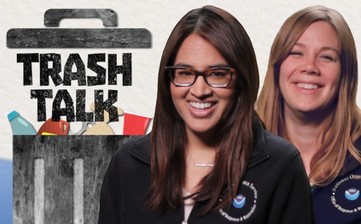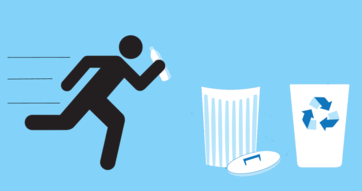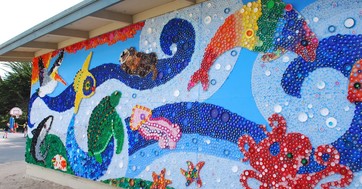| Featured Resource
 TRASH TALK
Get the conversation started about marine debris with our TRASH TALK video series, created in collaboration with NOAA's Ocean Today! The Regional Emmy® Award-winning mini-documentary covers all the basics of marine debris, including what marine debris is, where it comes from, what its impacts are, why plastic debris is so common, what the Great Pacific Garbage Patch is, and most importantly, what we can do about it. If you're short on time or want to focus on one topic in particular, the 15-minute video is also available as two-minute segments.
Whether you're looking for content to round out your school year, trying to find a video to keep your own kiddos occupied during the summer, or already planning for next school year, TRASH TALK is a fun and engaging way to get your students talking about marine debris!
Featured Activity
 Recycling Relay
Looking for an activity that will teach your students about marine debris and encourage them to get rid of some excess energy? If your answer is "yes," then the Recycling Relay is for you!
Students are broken into teams, each given an assortment of debris items. Near each team is a garbage can, then a recycling bin, and finally a bin for items that can be reused. The bins should be at varying distances from the students, with the garbage can the closest and the reuse bin the farthest away. Students' task is to put each item in its appropriate bin within a certain time frame. Students collect points as they go, with the most points earned for reusing items (the most desirable option). Debris items that are correctly put into the garbage can earn their team one point (a point for keeping it out of the environment!), items correctly in the recycling bin are three points, and those in the reuse bin are five points (students must explain how they can be reused). There is some room for interpretation (such as a plastic bottle being appropriate for both the recycling bin and the reuse bin), so students will have to use their knowledge and strategy to collect the most points.
Check out a demonstration of this and other activities in the Trash Talk Webinar for Educators!
Marine Debris Craft Corner
 (Photo Credit: Naomi Pollack/NOAA Ocean Guardian School Program)
Marine Debris Mural
Help spread the message about marine debris prevention and beautify your school at the same time by getting your students involved in some marine debris art! There are lots of ways to go about creating marine debris art, but murals can be a great way to have your class work together and can help make the issue visible to others.
Instructions:
Step 1: Decide where your mural will be located and what the appropriate size will be.
Step 2: Working with your students, design your mural and decide what colors you will need and what type of debris to include. Consider incorporating a theme to help raise marine debris awareness, such as depicting a local aquatic environment.
Step 3: Start collecting debris! Bonus points if you collect the debris from the environment, but you can also use items that would normally be discarded or recycled (such as saving all the bottle caps from the school's plastic bottle recycling). One word of warning is to make sure students aren't going out and purchasing more single-use plastic than they normally would in order to provide materials for your mural.
Step 4: Sort your debris by color (this step is easiest when performed in conjunction with Step 3).
Step 5: Draw your design on the wall where your mural will be located and indicate what colors go where.
Step 6: Get gluing! Soon enough you'll have a beautiful mural that will make the hallways look very spiffy while raising awareness of the marine debris issue.
|